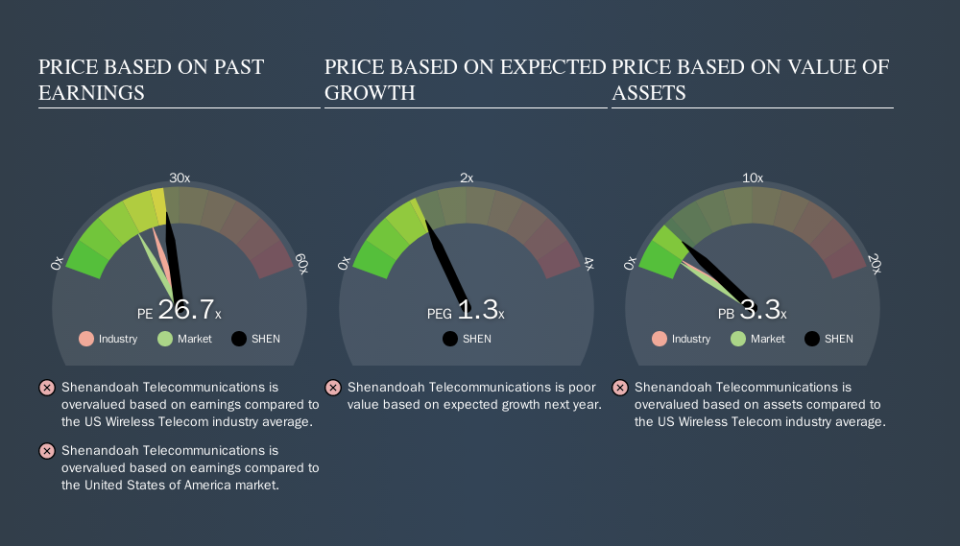Here's What Shenandoah Telecommunications Company's (NASDAQ:SHEN) P/E Is Telling Us

This article is written for those who want to get better at using price to earnings ratios (P/E ratios). We'll show how you can use Shenandoah Telecommunications Company's (NASDAQ:SHEN) P/E ratio to inform your assessment of the investment opportunity. Shenandoah Telecommunications has a P/E ratio of 26.72, based on the last twelve months. That means that at current prices, buyers pay $26.72 for every $1 in trailing yearly profits.
See our latest analysis for Shenandoah Telecommunications
How Do You Calculate A P/E Ratio?
The formula for P/E is:
Price to Earnings Ratio = Price per Share ÷ Earnings per Share (EPS)
Or for Shenandoah Telecommunications:
P/E of 26.72 = $30.89 ÷ $1.16 (Based on the trailing twelve months to June 2019.)
Is A High P/E Ratio Good?
A higher P/E ratio means that investors are paying a higher price for each $1 of company earnings. That isn't necessarily good or bad, but a high P/E implies relatively high expectations of what a company can achieve in the future.
How Does Shenandoah Telecommunications's P/E Ratio Compare To Its Peers?
One good way to get a quick read on what market participants expect of a company is to look at its P/E ratio. The image below shows that Shenandoah Telecommunications has a higher P/E than the average (22.4) P/E for companies in the wireless telecom industry.
That means that the market expects Shenandoah Telecommunications will outperform other companies in its industry. Shareholders are clearly optimistic, but the future is always uncertain. So investors should delve deeper. I like to check if company insiders have been buying or selling.
How Growth Rates Impact P/E Ratios
Earnings growth rates have a big influence on P/E ratios. That's because companies that grow earnings per share quickly will rapidly increase the 'E' in the equation. Therefore, even if you pay a high multiple of earnings now, that multiple will become lower in the future. A lower P/E should indicate the stock is cheap relative to others -- and that may attract buyers.
Shenandoah Telecommunications shrunk earnings per share by 29% over the last year. But it has grown its earnings per share by 13% per year over the last five years.
Don't Forget: The P/E Does Not Account For Debt or Bank Deposits
Don't forget that the P/E ratio considers market capitalization. So it won't reflect the advantage of cash, or disadvantage of debt. Hypothetically, a company could reduce its future P/E ratio by spending its cash (or taking on debt) to achieve higher earnings.
While growth expenditure doesn't always pay off, the point is that it is a good option to have; but one that the P/E ratio ignores.
So What Does Shenandoah Telecommunications's Balance Sheet Tell Us?
Shenandoah Telecommunications has net debt equal to 42% of its market cap. While that's enough to warrant consideration, it doesn't really concern us.
The Verdict On Shenandoah Telecommunications's P/E Ratio
Shenandoah Telecommunications has a P/E of 26.7. That's higher than the average in its market, which is 17.8. With modest debt but no EPS growth in the last year, it's fair to say the P/E implies some optimism about future earnings, from the market.
Investors should be looking to buy stocks that the market is wrong about. People often underestimate remarkable growth -- so investors can make money when fast growth is not fully appreciated. So this free visualization of the analyst consensus on future earnings could help you make the right decision about whether to buy, sell, or hold.
But note: Shenandoah Telecommunications may not be the best stock to buy. So take a peek at this free list of interesting companies with strong recent earnings growth (and a P/E ratio below 20).
We aim to bring you long-term focused research analysis driven by fundamental data. Note that our analysis may not factor in the latest price-sensitive company announcements or qualitative material.
If you spot an error that warrants correction, please contact the editor at editorial-team@simplywallst.com. This article by Simply Wall St is general in nature. It does not constitute a recommendation to buy or sell any stock, and does not take account of your objectives, or your financial situation. Simply Wall St has no position in the stocks mentioned. Thank you for reading.


